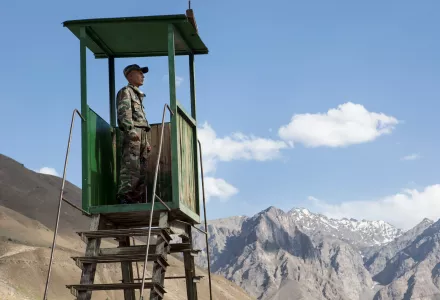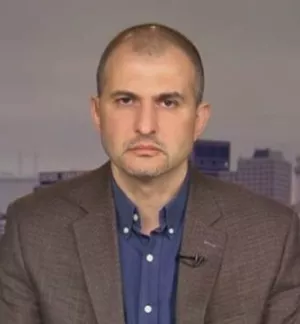
Foreword
Simon Saradzhyan, Founding Director, Russia Matters
In the fall of 2016 Fletcher School professor Monica Duffy Toft and I were completing work on an issue brief in which we argued that the Islamic State should be further rolled back and dismantled rather than allowed to remain in the hopes that it would somehow become a normal state. IS was already in retreat at the time, having lost much of the territories it had once controlled in Syria and Iraq. Watching this made me, like many other analysts of political violence, wonder what surviving foreign fighters—which, at the time, included an estimated 5,000-10,000 individuals from post-Soviet Eurasia—would do next if IS and other jihadist Salafi groups in the Levant disintegrated. To ascertain their next moves, one had to begin by discerning what made them leave their home countries and eventually go to IS in the first place, and whether/how their motivation may have evolved in the course of their stay with the group. As someone focusing on Eurasia, I was particularly worried about what nationals of the Central Asian states would decide to do next and what impact their decisions and actions would have as some of the regimes in these countries were considerably more fragile and, therefore, more vulnerable than, say, Vladimir Putin’s government. Another reason behind my interest in the subject is that the threat by violent extremists hailing from Central Asia had not been, in my view, as thoroughly examined as that posed by jihadists in and from Russia’s North Caucasus. Specifically, I had three sets of questions in mind: (1) What causes nationals of Central Asia to take up arms and participate in political violence and what might those of them who have gone to fight in Iraq/Syria decide to do next?; (2) if they decide to return to post-Soviet Central Asia en masse, can this region become a major source of violent extremism that transcends borders, and possibly continents, in the wake of IS’s demise?; and (3) is there a threat that chemical, biological, radiological or nuclear materials stored anywhere in Central Asia will be used by the returning nationals of Central Asia or others for purposes of WMD terrorism (considering that al-Qaeda has sought nuclear weapons and IS has used chemical weapons) and, if so, how serious is this threat? We asked three scholars to answer these questions. Vera Mironova is best known for her research on individual-level behavior in conflict environments and her fieldwork involving extensive interviews with former and active fighters. Edward Lemon is known for his research examining the intersection of authoritarian governance, religion, security and migration in Eurasia, along with his fieldwork in the region. Finally, William Tobey offers unparalleled expertise and years of experience in the U.S. government’s nuclear security and nonproliferation initiatives. Fortunately, they all agreed to delve into the issues, refining my initial questions in ways that made their answers even more illuminating than I had hoped for. The results of their tremendous efforts are presented here, skillfully fused into one narrative by Russia Matters editor Natasha Yefimova-Trilling with assistance from our project’s editorial assistant and student associates, in what I think is an insightful paper on the threat of violent extremism within and emanating from Central Asia.
Executive Summary
In the summer of 2018, the scenic, impoverished Central Asian nation of Tajikistan appeared in international headlines when Islamic State terrorists claimed credit for the killing of four Western cyclists who were run over by a car, then shot and stabbed to death. This was the first known terrorist attack on foreigners in Central Asia since a suicide bombing of the Chinese Embassy in Kyrgyzstan in 2016, and it appears to have been inspired by IS propaganda, though we do not know how much the group was involved in planning the attack, if at all. The violence serves as a jarring reminder that Islamist radicals from the five Central Asian nations once under Moscow’s control—Kazakhstan, Kyrgyzstan, Tajikistan, Turkmenistan and Uzbekistan—have become noteworthy players on the field of international terrorism. Thousands of radicals from formerly Soviet Central Asia have traveled to fight alongside IS in Syria and Iraq; hundreds more are in Afghanistan. Not counting the fighting in those three war-torn countries, nationals of Central Asia have been responsible for nearly 100 deaths in terrorist attacks outside their home region in the past five years. But many important aspects of the phenomenon need more in-depth study.
This research paper attempts to answer four basic sets of questions adapted from the ones mentioned in the foreword: (1) Is Central Asia becoming a new source of violent extremism that transcends borders, and possibly continents? (2) If so, why? What causes nationals of Central Asia to take up arms and participate in political violence? (3) As IS has been all but defeated in Iraq and Syria, what will Central Asian extremists who have thrown in their lot with the terrorist group do next? And (4) do jihadists from Central Asia aspire to acquire and use weapons of mass destruction? If so, how significant a threat do they pose and who would be its likeliest targets?
None of the answers is as straightforward as we would like, and far more attention should be paid to the differences and similarities among the five Central Asian states. But key findings generated by our research include the following:
- The civil war in Syria and the rise of IS in the Middle East have spurred an increase in the number of Central Asians participating in extremist violence beyond their home region; however, comparatively speaking, the international threat should not be exaggerated: Although Central Asians make up about 1 percent of the world’s population, they were responsible for 0.14 percent of the world’s terrorist attacks in the past decade, based on data from the Global Terrorism Database.
- While the causes of radicalization vary widely, field research by two of the authors, as well as other scholars, suggests that two significant factors are (a) real and/or perceived injustices or failures that lead to an extreme rejection of society and (b) affinity for “a culture of violence.” These factors can overlap with a search for adventure and/or a sense of belonging and meaning. Contrary to popular belief, relative poverty, religiosity and lack of education do not seem to be strong predictors of radicalization.
- These authors’ research also suggests that a significant number of Central Asian extremists who went to fight in the Middle East became radicalized abroad, primarily while working in Russia or Turkey.
- Other scholars’ research suggests that recent terrorist attacks and plots with a jihadist agenda in peaceful countries have more often been the work of local residents without combat experience than by former combatants.
- The next steps of Central Asian jihadists in foreign combat zones are exceedingly difficult to predict. Those who manage to escape from Iraq and Syria will have three basic options: to continue their fight in a different conflict zone, Afghanistan being the most likely; to go back to Central Asia, which does not seem like an option many find appealing; and to settle in a third country, whether to live peacefully or to keep fighting.
- The evidence indicates that Afghanistan-based militant groups, most notably the Islamic State Khorasan Province (ISKP), are targeting Central Asian recruits. But the inflow of foreign fighters is less intense than to Syria and Iraq in 2014-2015.
- While lone attackers attempting to commit acts of violence—whether inspired by radical propaganda or other factors—will continue to be difficult to identify before they do damage, policymakers and law-enforcement authorities would be wise to cooperate across borders in tracking those Central Asian extremists who plug into networks of like-minded radicals and/or criminal groups.
- Much work needs to be done to provide better security for the radiological sources in use in Central Asia; however, the threat vectors for chemical, biological, radiological and nuclear weapons involving Central Asia appear not to pose an imminent danger either within the region or outside it.
Lemon, Edward, Vera Mironova and William H. Tobey. “Jihadists from Ex-Soviet Central Asia: Where Are They? Why Did They Radicalize? What Next?.” Russia Matters, Fall 2018
The full text of this publication is available via Russia Matters.








